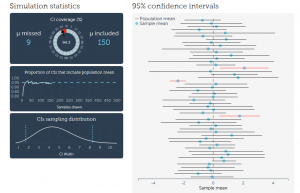visualização do intervalo de confiança
Posted by Armando Brito Mendes | Filed under estatística, materiais ensino, visualização
Boa forma de visualizar o conceito de Intervalo de Confiança Aleatório.
About the visualization
Some say that a shift from hypothesis testing to confidence intervals and estimation will lead to fewer statistical misinterpretations. Personally, I am not sure about that. But I agree with the sentiment that we should stop reducing statistical analysis to binary decision-making. The problem with CIs is that they are as unintuitive and as misunderstood p-values and null hypothesis significance testing. Moreover, CIs are often used to perform hypothesis tests and are therefore prone to the same misuses as p-values.
Tags: belo, definição, inferência
Rtips. Revival 2014!
Posted by Armando Brito Mendes | Filed under estatística, matemática, software
Montes de exemplos de R numa única longa página.
Tags: análise de dados, Estat Descritiva, inferência, R-software, software estatístico
Rice Virtual Lab in Statistics
Posted by Armando Brito Mendes | Filed under estatística, materiais ensino
Referências úteis para conceitos de estatística básica.
 |
HyperStat Online An online statistics book with links to other statistics resources on the web. |
| Simulations/Demonstrations Java applets that demonstrate various statistical concepts. |
|
 |
Case Studies Examples of real data with analyses and interpretation |
| Analysis Lab Some basic statistical analysis tools. |
Tags: Estat Descritiva, inferência
SticiGui – online statistics book
Posted by Armando Brito Mendes | Filed under estatística, materiais ensino
- Chapter 0, Preface.
- Chapter 1, Introduction.
- Chapter 2, Reasoning and Fallacies.
-
- Rules of reasoning, arguments, validity and soundness, some valid rules of reasoning, formal fallacies, common formal fallacies, informal fallacies, fallacies of relevance and fallacies of evidence, fallacies of relevance, common fallacies of relevance, fallacies of evidence, common fallacies of evidence, summary, key terms.
- Chapter 3, Statistics.
- Chapter 4, Measures of Location and Spread.
- Chapter 5, Multivariate Data and Scatterplots.
- Chapter 6, Association.
- Chapter 7, Correlation and Association.
-
- The correlation coefficient, the effect of nonlinear association, homoscedasticity and heteroscedasticity and outliers on the correlation coefficient, summary, key terms.
- Chapter 8, Computing the Correlation Coefficient.
- Chapter 9, Regression.
- Chapter 10, Regression Diagnostics.
- Chapter 11, Errors in Regression.
- Chapter 12, Counting.
- Chapter 13, The Meaning of Probability: Theories of probability.
- Chapter 14, Set Theory: The Language of Probability.
- Chapter 15, Categorical Logic.
- Chapter 16, Propositional Logic.
- Chapter 17, Probability: Axioms and Fundaments.
- Chapter 18, The “Let’s Make a Deal” (Monty Hall) Problem.
- Chapter 19, Probability Meets Data.
- Chapter 20, Random Variables and Discrete Distributions.
-
- Random variables, sampling from 0-1 boxes, geometric distribution, the negative binomial distribution, sampling without replacement, the hypergeometric distribution, calculating binomial, geometric, hypergeometric, and negative binomial probabilities, discrete distributions, case study: trade secret litigation, summary, key terms.
- Chapter 21, The Long Run and the Expected Value.
-
- The Law of Large Numbers, implications of the law of large numbers, expected value of a random variable, expected value of the sample sum, expected value of binomial hypergeometric distributions, properties of the expected value, expected value of the sample mean and sample percentage, gambling and fair bets, expected values of some common distributions, summary, key terms.
- Chapter 22, Standard Error.
-
- Expected value of a transformation of a random variable, standard error of random variables, the standard error transformations of a random variable, independent random variables, standard errors of some common random variables, the SE of a single draw from a box of numbered tickets, SE of the sample sum of n random draws with replacement from a Box of Tickets, the SE of the sample mean of n random draws from a box of numbered tickets, the square-root law, the law of averages, the standard error of the binomial, geometric and negative binomial distributions, SE of the sample sum and mean of a simple random sample, the SE of the hypergeometric distribution, the finite population correction, summary, key terms.
- Chapter 23, The Normal Curve, the Central Limit Theorem, and Markov’s and Chebychev’s Inequalities for Random Variables.
-
- The normal approximation, standard units for random variables, the normal curve, the normal approximation to probability histograms, the continuity correction, the normal approximation to the hypergeometric distribution, Markov’s and Chebychev’s inequalities for random variables, summary, key terms.
- Chapter 24, Sampling.
-
- Parameters and statistics, why sample?, sample surveys, The Hite Report, bias in surveys, Sampling designs: cluster sampling, stratified sampling, multistage sampling, hybrid designs, ways of drawing samples, convenience samples, quota samples, systematic samples, probability samples, simple random samples, systematic random samples, Sampling from hypothetical populations, summary, key terms.
- Chapter 25, Estimating Parameters from Simple Random Samples.
-
- Quantifying the error of estimators: bias, standard error, and mean squared error, estimating means and percentages, a conservative estimate of the SE of the sample percentage, the Bootstrap estimate of the SD of a list of zeros and ones, the sample standard deviation and the sample variance, caveats, summary, key terms.
- Chapter 26, Confidence Intervals.
-
- Confidence intervals, conservative confidence intervals for percentages, conservative confidence intervals for the mean of bounded populations, approximate confidence intervals for percentages, approximate confidence intervals for the population mean, exact confidence intervals for percentages, confidence intervals for the median and percentiles, summary.
- Chapter 27, Hypothesis Testing: Does Chance explain the Results?.
-
- Hypothesis testing, Examples of hypothesis testing problems, significance level and power, test statistics and P-values, hypotheses about parameters; one-sided and two-sided alternatives, case study: employment discrimination, caveats, the meaning of rejection, statistical significance and practical importance, interpreting P-values, multiplicity and data mining, garbage in, garbage out, summary.
- Chapter 28, Does Treatment Have an Effect?.
-
- The Method of Comparison, confounding, historical controls, longitudinal and cross-sectional comparisons, Simpson’s Paradox, experiments and observational studies, assessing online instructions, the Placebo Effect, John Snow’s study of the mode of communication of cholera, The Kassel Dowsing Experiment, summary.
- Chapter 29, Testing Equality of Two Percentages.
-
- Fisher’s Exact Test for an effect–dependent samples, the normal approximation to Fisher’s Exact Test, testing equality of two percentages using independent samples, Fisher’s Exact Test using independent samples, the Z test for the equality of two percentages using independent Samples, the normal approximation to Fisher’s exact test and the z Test, summary, key terms.
- Chapter 30, Approximate Hypothesis Tests: the z Test and the t Test.
-
- z Tests, P values for z tests, examples of z tests, z test for a population percentage, the z test for a population mean, z-test for a difference of population means (paired samples, independent samples), t tests, nearly normally distributed populations, Student’s t-curve, t test for the mean of a nearly normal population, hypothesis tests and confidence intervals, confidence intervals using Student’s t curve, summary, key terms
- Chapter 31, The Multinomial Distribution and the Chi-Squared Test for Goodness of Fit.
Tags: Estat Descritiva, inferência
Tutorial: How to detect spurious correlations
Posted by Armando Brito Mendes | Filed under estatística, materiais ensino
Tutorial: How to detect spurious correlations, and how to find the real ones
Specifically designed in the context of big data in our research lab, the new and simple strong correlation synthetic metric proposed in this article should be used, whenever you want to check if there is a real association between two variables, especially in large-scale automated data science or machine learning projects. Use this new metric now, to avoid being accused of reckless data science and even being sued for wrongful analytic practice.
Tags: data mining, Estat Descritiva, inferência
khanacademy: Lei dos grandes números
Posted by Armando Brito Mendes | Filed under estatística, materiais ensino, videos
Vídeo original: Law of Large Numbers (https://www.khanacademy.org/math/probability/random-variables-topic/random_variables_prob_dist/v/law-of-large-numbers) A Khan Academy Portugal disponibiliza explicações online de Matemática gratuitas desde o 1º até ao 12º ano de escolaridade. Este vídeo foi produzido pela Khan Academy e traduzido para português pela Fundação Portugal Telecom (ver todos os vídeos disponíveis em http://fundacao.telecom.pt/khanacademy).
Tags: inferência
khanacademy: Variáveis aleatórias
Posted by Armando Brito Mendes | Filed under estatística, materiais ensino, videos
Vídeo original: Introduction to Random Variables? (https://www.khanacademy.org/math/probability/independent-dependent-probability/old_prob_videos/v/introduction-to-random-variables) A Khan Academy Portugal disponibiliza explicações online de Matemática gratuitas desde o 1º até ao 12º ano de escolaridade. Este vídeo foi produzido pela Khan Academy e traduzido para português pela Fundação Portugal Telecom (ver todos os vídeos disponíveis em http://fundacao.telecom.pt/khanacademy).
Tags: Estat Descritiva, inferência
khanacademy: Distribuição Binomial
Posted by Armando Brito Mendes | Filed under estatística, materiais ensino, videos
Vídeo original: Binomial Distribution 1 (https://www.khanacademy.org/math/probability/random-variables-topic/binomial_distribution/v/binomial-distribution-1) A Khan Academy Portugal disponibiliza explicações online de Matemática gratuitas desde o 1º até ao 12º ano de escolaridade. Este vídeo foi produzido pela Khan Academy e traduzido para português pela Fundação Portugal Telecom (ver todos os vídeos disponíveis em http://fundacao.telecom.pt/khanacademy).
Tags: inferência
khanacademy: Distribuição de Bernoulli
Posted by Armando Brito Mendes | Filed under estatística, materiais ensino, videos
Vídeo original: Mean and Variance of Bernoulli Distribution Example (http://www.khanacademy.org/video/mean-and-variance-of-bernoulli-distribution-example) A Khan Academy Portugal disponibiliza explicações online de Matemática gratuitas desde o 1º até ao 12º ano de escolaridade. Este vídeo foi produzido pela Khan Academy e traduzido para português pela Fundação Portugal Telecom (ver todos os vídeos disponíveis em http://fundacao.telecom.pt/khanacademy).
Tags: inferência
khanacademy: Distribuição Normal
Posted by Armando Brito Mendes | Filed under estatística, materiais ensino, videos
Vídeo original: ck12.org Exercise: Standard Normal Distribution and the Empirical Rule(http://www.khanacademy.org/video/ck12-org-exercise–standard-normal-distribution-and-the-empirical-rule) A Khan Academy Portugal disponibiliza explicações online de Matemática gratuitas desde o 1º até ao 12º ano de escolaridade. Este vídeo foi produzido pela Khan Academy e traduzido para português pela Fundação Portugal Telecom (ver todos os vídeos disponíveis em http://fundacao.telecom.pt/kha
Tags: inferência





